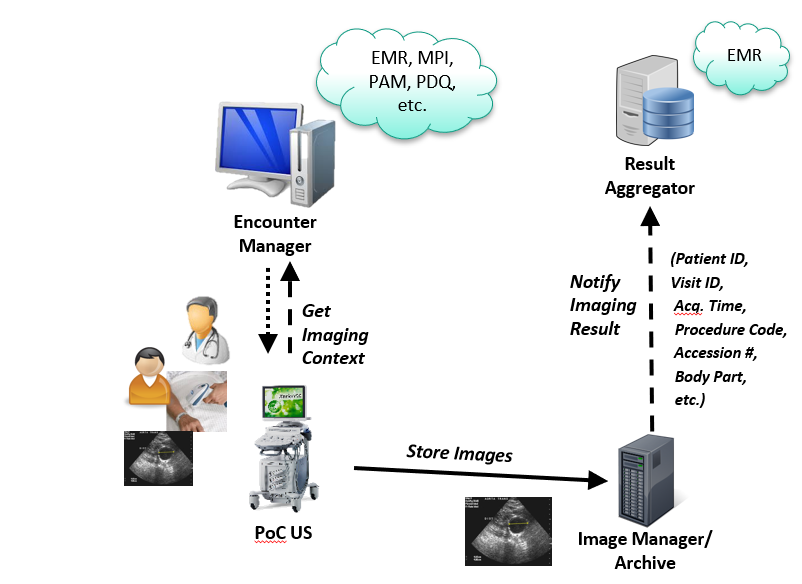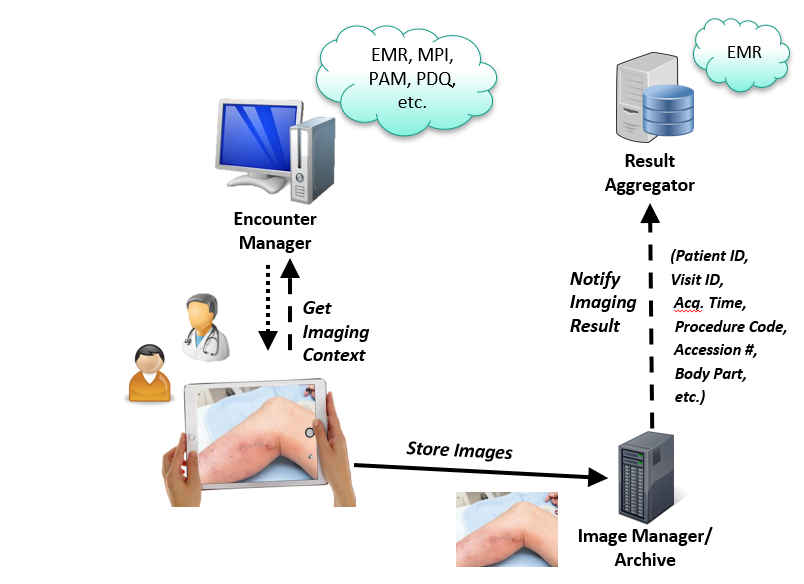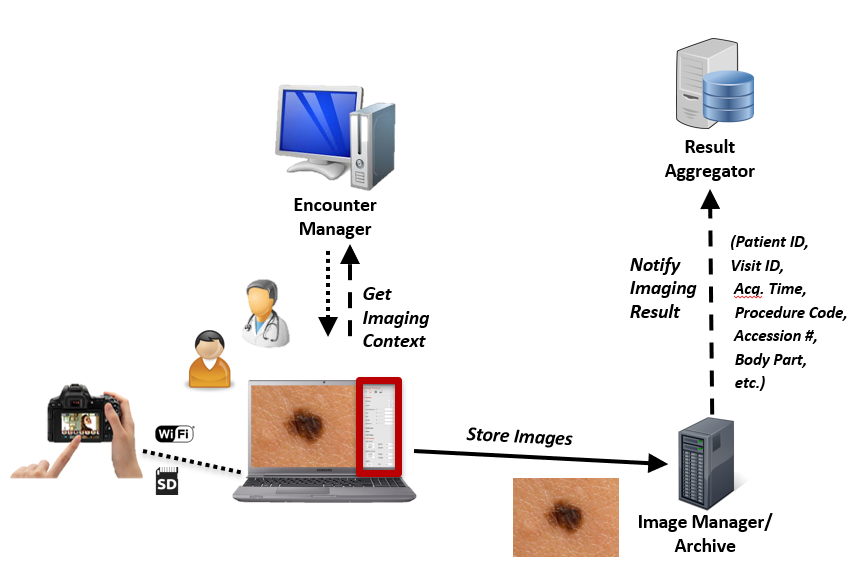Difference between revisions of "Encounter-Based Imaging Workflow"
| (7 intermediate revisions by the same user not shown) | |||
| Line 4: | Line 4: | ||
==Summary== | ==Summary== | ||
| − | + | Medical imaging that is encounter-driven (e.g. during a dermatology consultation, the physician decides to capture pictures of a mole for future comparison) continues to grow significantly. | |
| − | '' | + | '''Effective use of images depends on them being well-documented and integrated into the medical record.''' For order-based imaging (such as a CT scan, an echo work-up, or an angiography procedure), this is handled by the use of order-driven worklists and integrated systems as described in the [[Scheduled Workflow]] Profile. Encounter-based imaging needs similar robust integration, data management, and efficient workflows. '''Accurate metadata is key.''' |
| − | + | Essentially, in EBIW a patient ID or visit ID is used to query for full metadata (patient demographics, admission details, etc) which are applied to the image when stored, along with procedure details (anatomy, imaging procedure type, etc), making it possible to store, manage, find, and use the images when needed. To facilitate EMR entries, a notification is sent to the EMR containing all the details needed to index the images and link them to the medical record. | |
| − | + | [[Image:EBIW_Diagram_POCUS.png|500px]] | |
| − | + | The same pattern applies to tablets, smartphones and digital cameras. As long as the metadata is assembled before sending the images to storage, it is flexible as to whether the query happens before or after the images are acquired, and whether the procedure metadata is collected on the device or on a separate screen. | |
| − | + | [[Image:EBIW_Diagram_Tablet.png|500px]] | |
| − | + | [[Image:EBIW_Diagram_SLR.png|500px]] | |
| − | + | ==Benefits== | |
==Details== | ==Details== | ||
| Line 45: | Line 45: | ||
'''Documents:''' | '''Documents:''' | ||
| − | [ | + | [https://www.ihe.net/uploadedFiles/Documents/Radiology/IHE_RAD_Suppl_EBIW.pdf IHE Encounter-based Imaging Workflow Profile] |
| − | + | ||
| − | |||
| − | |||
'''Underlying Standards:''' | '''Underlying Standards:''' | ||
| Line 56: | Line 54: | ||
==See Also== | ==See Also== | ||
| − | |||
'''Related Profiles''' | '''Related Profiles''' | ||
| − | + | * [[Scheduled Workflow]] [SWF.b] provides equivalent integration for order-based imaging. | |
| + | * [[Cross-enterprise Document Sharing for Imaging]] [XDS-I] can be used to share encounter-based images between sites over a network. | ||
| − | + | This page is based on the [[Profile Overview Template]] | |
| − | |||
| − | |||
| − | |||
| − | |||
| − | |||
| − | |||
| − | |||
| − | |||
| − | |||
| − | |||
| − | |||
| − | |||
| − | |||
| − | |||
| − | |||
| − | |||
| − | |||
| − | |||
| − | |||
[[Category:Profiles]] | [[Category:Profiles]] | ||
| − | |||
| − | |||
[[Category:RAD Profile]] | [[Category:RAD Profile]] | ||
[[Category:DICOM]] | [[Category:DICOM]] | ||
| + | [[Category:DICOMweb]] | ||
[[Category:HL7v2]] | [[Category:HL7v2]] | ||
Latest revision as of 13:14, 15 December 2020
Encounter-Based Imaging Workflow (EBIW) captures images acquired in the context of an encounter between a patient and a healthcare provider, links them with critical metadata, and notifies the EMR.
Summary
Medical imaging that is encounter-driven (e.g. during a dermatology consultation, the physician decides to capture pictures of a mole for future comparison) continues to grow significantly.
Effective use of images depends on them being well-documented and integrated into the medical record. For order-based imaging (such as a CT scan, an echo work-up, or an angiography procedure), this is handled by the use of order-driven worklists and integrated systems as described in the Scheduled Workflow Profile. Encounter-based imaging needs similar robust integration, data management, and efficient workflows. Accurate metadata is key.
Essentially, in EBIW a patient ID or visit ID is used to query for full metadata (patient demographics, admission details, etc) which are applied to the image when stored, along with procedure details (anatomy, imaging procedure type, etc), making it possible to store, manage, find, and use the images when needed. To facilitate EMR entries, a notification is sent to the EMR containing all the details needed to index the images and link them to the medical record.
The same pattern applies to tablets, smartphones and digital cameras. As long as the metadata is assembled before sending the images to storage, it is flexible as to whether the query happens before or after the images are acquired, and whether the procedure metadata is collected on the device or on a separate screen.
Benefits
Details
<A few paragraphs, if appropriate, providing more details (mostly in user-speak, not tech-speak) on what the profile does and how it works.>
<If the user might be familiar with the mechanisms used by the profile, you can mention them here. E.g. Evidence Documents is based on DICOM Structured Report (SR) Templates.>
<If the user might have an appreciation for the problems addressed in the profile, you can mention them here, but keep it short. E.g. Mapping HL7 Order fields to DICOM Modality Worklist attributes can be inconsistent in the marketplace, so Scheduled Workflow provides vendors with more detailed instructions.>
Systems Affected
<List (in user terms) the types of systems they might expect to have implemented actors from this profile, e.g. RIS, PACS, HIS, CAD Workstation, etc. and for each, how it would participate.>
- PACS systems may store, manage, and/or display Evidence Documents.
- Display systems may query, retrieve and display Evidence Documents.
- Reporting workstations may retrieve, process and include details from Evidence Documents in reports
Actors & Transactions:
<Insert an actor-transaction diagram, and or list of Content Definitions>
Specification
Profile Status: Trial Implementation
Documents:
IHE Encounter-based Imaging Workflow Profile
Underlying Standards:
See Also
Related Profiles
- Scheduled Workflow [SWF.b] provides equivalent integration for order-based imaging.
- Cross-enterprise Document Sharing for Imaging [XDS-I] can be used to share encounter-based images between sites over a network.
This page is based on the Profile Overview Template


